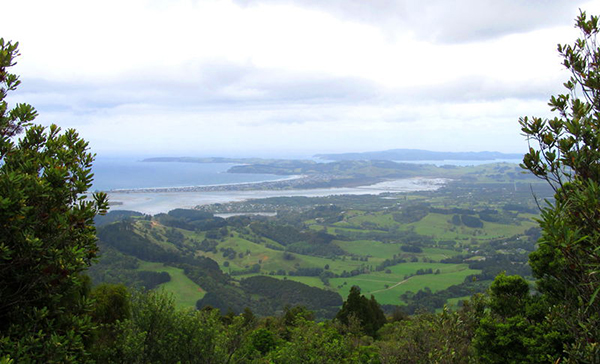Mahurangi Action to submit to building a better region

Overlooked Name: Despite prodding from the Mahurangi Magazine, the Royal Commission on Auckland Governance overlooked the top contender for a replacement for Rodney, whose namesake, Admiral George Brydges Rodney, like so many whose names litter the coastline, never set foot in Aotearoa. Whangateau, Ōmaha, Tawharanui and Kawau, viewed from Mount Tamahunga. image Ecofest
The royal commissioners had recommended list members. List councillors, really; ten of Auckland’s 23 councillors, the Royal Commission on Auckland Governance proposed, were to be elected to supposedly represent the whole region, rather than a single ward.
Some consider that the government, by doing away with those ten councillors elected ‘at large’, condemned the region to being ruled by parochial interests. What seriously weakens any assertion that the Auckland’s new governance arrangements would have been just fine, had not Rodney Hide and the government interfered, is the host of shortcomings of the commissioners’ master plan, too numerous to detail here.
The commission’s most obvious deficiency was allowing the direct election of a mayor, with unprecedented powers, without requiring preferential voting. In November’s elections, the Auckland mayoralty could well evolve into a three-way race between Victoria Crone, Phil Goff and John Palino. Palino, like Trump, although far from being preferred by a majority of voters, could, if he snatched a couple more votes than either of his main rivals, end up being mayor. Which is why countries, famously France, have run-off mayoral elections. But, thanks to the ridiculously simple-to-use ranking system that was perfected in Aotearoa, the cost of run-off elections is obviated by the simple expedient of recording more than just the voters’ first preference, with the computer doing the rest.
The 2009 recommendations of the royal commission, in its aspirations for a mayor for their brainchild, are almost comically wistful:
Auckland needs an inspirational leader, inclusive in approach and decisive in action. Auckland needs a person who is able to articulate and deliver on a shared vision, and who can speak for the region, and deliver regional priorities decisively. The Auckland Council will be led by a mayor who is elected by all Aucklanders.
Aside from the qualities that any mayor might bring to the office being entirely beyond the decree even of royal commissioners, without preferential voting it is extremely unlikely that an Auckland mayor will be elected by a simple majority of voters, much less anything approaching even a rhetorical approximation of ‘all Aucklanders.’ In addition to the commission’s culpable reliance on abjectly undemocratic first-past-the-post voting, with a turnout of only 35.5%, incumbent Mayor Len Brown was re-elected in 2013 with less than 17% support of registered voters.
But it is unlikely that the Local Government Commission, in its call for alternative applications for local government reorganisation in the Auckland Council area will be interested in addressing core electoral deficiencies. Alternative applications, of course, to the bid to breakaway from Auckland Council by Rodney interests, determined that the new structure wouldn’t work, rather than roll up sleeves and help make it work. That said, the 20 one-size-fits-all local boards, plus Waiheke, was fuel to the fire—albeit a substantial improvement on the commissioners’ plan for a mere six, essentially toothless, ‘local councils’.
Rodney, with more than a third of the region’s landmass, is an impossibly disparate area to be represented by one local board. At the very least, it should be split into a Kaipara board and a northern Rodney one, but given the distinctive community of interest north of the Tamahunga Range, separate Wellsford- and Warkworth-centric local boards should at least be discussed.
One thing the royal commissioners did get right was their recommendation that, what became wards, should take Māori names where possible. However:
This, despite the April 2009 Mahurangi Magazine advocacy of Tamahunga as the top, and natural, geographic contender. The case for Tamahunga is, of course, even stronger for northern, than for the whole of, Rodney.
Creating an additional local board does not compromise electoral integrity because no changes would be required to the Rodney Ward, whose boundaries are set by the Electoral Commission. One additional board member would be required, to bring the combined members representing the Wellsford and Warkworth subdivisions to five—seriously regrettable the wonderful old term riding wasn’t employed, rather thansubdivision.
Clearly, 22 local boards would cost more to administer than 21, but the alternative, the preposterous and wholly unlikely hiving off of northern Rodney as a new unitary authority, would cost hundreds of millions, and, of itself, would not guarantee better governance—the reverse in fact, with the area subject to all the pressures of being part of New Zealand’s fastest growing regions, and none of the economies of scale in dealing with them.
With the deadline for submitting an alternative application less than a month away—Friday 24 June—the time for consultation with members of Mahurangi Action is short. Fortunately, the Mahurangi Magazine, since January 2008, has published 33 articles canvassing support for better regional governance, meaning Mahurangi Action’s application can draw on that rolling mandate.
In October 2010 the Mahurangi Magazine predicted:
The statement drew an angry response from a secessionist, and a demand for a retraction-or-face-legal-action, which of course went unheeded. In the six years since, an unknowable amount of local energy has been sapped by the dogged and amateurish pursuit of a new council that would somehow magically enshrine the small-government dogma of its lead proponents. High Court action, in itself, doesn’t come cheap to any of the parties, not least of all to the long-suffering taxpayer.
Rather than dignify these disruptive, small-minded and ultimately futile efforts, the Mahurangi Magazine resolved to not provide them further oxygen. But with the Local Government Commission now keen to hear from the community, it is time to call for a timely tweak to the region’s governance model.
And to reject what was always little more than a thinly disguised ploy to turn northeastern Rodney into an unfettered developer’s El Dorado, à la famously misgoverned north-of-the-regional-border Mangawhai.
